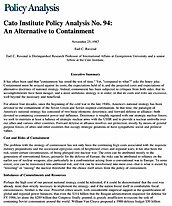For almost four decades, since the beginning of the cold war in the late 1940s, America’s national strategy has been devoted to the containment of the Soviet Union and Soviet-inspired communism. In that time, the paradigm of America’s national strategy has consisted of two basic elements: deterrence, and forward defense or alliance–both devoted to containing communist power and influence. Deterrence is roughly equated with our strategic nuclear forces; we seek to maintain at least a balance of strategic nuclear arms with the USSR and to provide a nuclear umbrella over our allies and various other countries. Forward defense or alliance involves our protection, mostly by means of general purpose forces, of allies and other countries that occupy strategic positions or have sympathetic social and political values.
An Alternative to Containment
It has often been said that “containment has stood the test of time.” Yet, “compared to what?” asks the hoary joke. Containment must be arrayed against its costs, the expectations held of it, and the projected costs and expectations of alternative doctrines of national strategy. Indeed, containment has been subjected to critiques from both sides: that its accomplishments have been meager, and a more ambitious strategy is in order; or that its costs and risks are excessive, well beyond the necessary and beneficial.

This work is licensed under a Creative Commons Attribution-NonCommercial-ShareAlike 4.0 International License.
